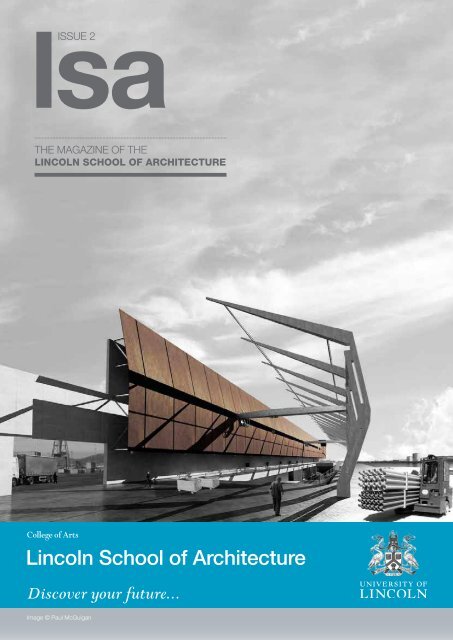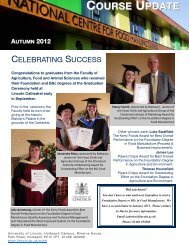LSA Magazine Issue 2 (PDF) - University of Lincoln
LSA Magazine Issue 2 (PDF) - University of Lincoln
LSA Magazine Issue 2 (PDF) - University of Lincoln
- No tags were found...
You also want an ePaper? Increase the reach of your titles
YUMPU automatically turns print PDFs into web optimized ePapers that Google loves.
lsaISSUE 2The <strong>Magazine</strong> <strong>of</strong> the<strong>Lincoln</strong> School <strong>of</strong> ARCHITECTURECollege <strong>of</strong> Arts<strong>Lincoln</strong> School <strong>of</strong> ArchitectureDiscover your future...Image © Paul McGuigan
Welcome tothe School <strong>of</strong>ArchitectureWHYCHOOSE<strong>LSA</strong>?Welcome to the School<strong>of</strong> Architecture, at what isproving to be an excitingtime in the <strong>University</strong>’s shorthistory. We are seeing acontinuing improvement inthe <strong>University</strong> <strong>of</strong> <strong>Lincoln</strong>’sleague position reflectingthe quality <strong>of</strong> the studentexperience we <strong>of</strong>fer.It has been another busy andsuccessful year for the <strong>Lincoln</strong> School<strong>of</strong> Architecture. I am delighted toreport that the validated Architectureprogrammes, including the BA (Hons)Architecture, have received renewal<strong>of</strong> their prescription by the ArchitectsRegistration Board (ARB) for thenext four years, and unconditionalrevalidation by the Royal Institute <strong>of</strong>British Architects (RIBA) until 2017.Our student society, the <strong>Lincoln</strong>Architecture Society (LAS), has cometop amongst all the societies in the<strong>University</strong> and over the past year hascontributed considerably to the life <strong>of</strong>the School, running our public lectureprogramme and collaborating with<strong>Lincoln</strong>shire Society <strong>of</strong> Architects inpromoting Architecture to the generalpublic. You can read more about LASon pages 8 and 9.I am also pleased to announce thatthis year, the School has appointedtwo new Pr<strong>of</strong>essors: Pr<strong>of</strong>essor HughByrd from New Zealand, who isPr<strong>of</strong>essor <strong>of</strong> Architecture, and whoseresearch concentrates largely onthe environmental performance <strong>of</strong>buildings; and Dr Anna Catalani fromItaly, who is Reader in Architectureand whose research interests fallwithin cultural heritage and museumand exhibition design. I am sure thatboth will help us to build upon ourestablished strengths in research andplay a fundamental role in shaping theSchool’s new and exciting researchand enterprise agenda.Derek CottrellHead <strong>of</strong> <strong>Lincoln</strong> School <strong>of</strong> Architecture<strong>Lincoln</strong> School <strong>of</strong> Architecture is the place to be if you want to learn how to be a successfulpractising designer. At BA level our core subjects are Architecture, Interior Architectureand Design, and Design for Exhibition and Museums, but our graduates go on to careersin many areas <strong>of</strong> design and/or see their degrees as preparation for further postgraduatestudy in specialist areas such as sustainability, housing, interiors, urban design, planning,environmental design, landscape design, international development, exhibitions and otherareas <strong>of</strong> spatial or communicative design, all <strong>of</strong> which are also <strong>of</strong>fered here at <strong>Lincoln</strong>.We <strong>of</strong>fer a supportive yet challengingenvironment in which to develop yourcreativity and design skills, and are proudthat we aim to help you to eventually findyour own voice as a designer.Most <strong>of</strong> your learning will take placein the studio, through project-based,design-centred teaching. The emphasis<strong>of</strong> the studios is group learning, <strong>of</strong>tenthrough projects which have live clientsto simulate practice. Studios are a placein which to study, learn and socialise.Much <strong>of</strong> the learning happens in groupssupported by tutor-led seminars andtutorials. The teaching is supported bywell equipped workshops with goodquality facilities, including metal workingequipment, rapid prototyping andlaser cutting resources which allowstudents to develop their designunderstanding through makingphysical models and installations.The majority <strong>of</strong> assessment isthrough studio projects and writtenresearch projects rather than formalwritten examinations. All modules areunderpinned by a lecture and seminarprogramme which covers history, theory,pr<strong>of</strong>essional practice, sustainability andtechnology from a global perspective.Our approach to teaching has beencontinuously developed and refinedover the last fifty years to combine thebest aspects <strong>of</strong> year-based, studioorganisation and small-group teaching.As a result, our graduates have highlevels <strong>of</strong> competency in CAD and visualrepresentation and are self-reliant.They possess well developed teamskills, key business attributes and strongresearch capability, necessary for successin the modern world. Opportunities forstudy trips abroad, our international mix<strong>of</strong> staff and the international summerschools held in the school all help toprepare our graduates for careers whichmay take them anywhere in the world.The pr<strong>of</strong>essional architecturalprogrammes are validated by the RoyalInstitute <strong>of</strong> British Architects (RIBA) andprescribed by the Architects RegistrationBoard (ARB), and all the programmeshave a strong alumni network.2 3
ARCHITECTURECollaborationArcHitectureDesign is at the heart <strong>of</strong> <strong>Lincoln</strong>’s BA (Hons) Architecture programme, which is fullyvalidated by the Royal Institute <strong>of</strong> British Architects (RIBA), equivalent to their Part 1qualification, as well as being prescribed by the Architect’s Registration Board (ARB).Assessment is through design projects which are developed in small studio groups underthe guidance <strong>of</strong> a design tutor. We think <strong>of</strong> the studio as a co-operative and productiveenvironment in which the student discovers his or her own voice as a designer.Twitter garden winsGold at ChelseaFlower ShowFrom the outset, the student learnsto apply drawing techniques forinvestigation and communication,together with computer-aided designtechniques and hands-on modellingand construction techniques. Studiesin history, theory, construction andenvironment are integrated with designprojects. The aim is to help the studentacquire a complete tool-kit <strong>of</strong> skills forarchitectural design and production.The first year programme is designedto release creative potential, exploredesign processes and lay a foundation<strong>of</strong> cultural and technical knowledge.The second year programme addressessocial, theoretical and contextual issues<strong>of</strong> living in the contemporary city.Design projects aim to build confidencein responding with imagination, humanityand concern for the environment.The third year programme gives thestudent the opportunity to research,experiment and demonstrate thesynthesis <strong>of</strong> imagination andpractical resolution.According to the Architects’ Journal;7/26/2012, Vol. 236 <strong>Issue</strong> 4, p58-61,“The <strong>Lincoln</strong> degree show was a mix<strong>of</strong> styles and work-based themes verymuch reflecting the diverse range <strong>of</strong>tutors the school employs. This resultsin an interesting blend <strong>of</strong> projectsranging from well considered pragmaticsolutions which are clearly safe andcould commence on site tomorrow, tobold, futuristic schemes, which <strong>of</strong>tendo appear to overlook fundamentalelements such as structure in thesearch for aesthetic nirvana”.A unique digital garden created by the <strong>University</strong> <strong>of</strong> <strong>Lincoln</strong> won Gold at this year’s RHSChelsea Flower Show. Fresh garden “Digital Capabilities” responded to live Twitter activity,enabling the public to directly influence how the garden appeared at any one time.The impressive structure wasconstructed by a team <strong>of</strong> staffand students from the School <strong>of</strong>Architecture. Architects and <strong>Lincoln</strong>School <strong>of</strong> Architecture tutors RichardWright and Barbara Griffin were bothapproached earlier in the year to jointhe team for the project. Their initialrole was to facilitate the construction<strong>of</strong> the project, namely to construct aninnovative show garden for this year’sRHS Chelsea Flower Show in Londonwhich responded to online activity.The architects quickly entered intoa dynamic collaborative designrelationship with other areas <strong>of</strong> the<strong>University</strong>: computer scientists,interactive designers, garden designersand even the Head <strong>of</strong> the School <strong>of</strong>Psychology, who were all intrinsic to thesuccess <strong>of</strong> this project. Right from theinitial proposals, this multidisciplinaryteam generated a new garden designbased loosely around the originalconceptual underpinnings, and studentsfrom the School’s Master <strong>of</strong> Architecturestudents, together with <strong>University</strong>technicians, worked incredibly hard toconstruct the garden, spending manyevenings in the Architecture workshopin order to meet the tight deadline.The garden was divided diagonally byan autonomous-panelled screen whichseparated the planting <strong>of</strong> two distinctzones. A tapestry <strong>of</strong> familiar plantsand foliage then greeted visitors, withthe partially obscured exotic plantingbehind the partition providing a dramaticcontrast. The panelled screen respondedin real-time to the ‘buzz’ <strong>of</strong> excitementabout RHS Chelsea Flower Show, asmeasured by activity on Twitter using the#rhschelsea tag, with the inner depths <strong>of</strong>the garden only being seen when publicexcitement was at its peak.Davina McCall, Kim Wilde and JackDee were just three <strong>of</strong> the celebritiesspotted interacting with the gardenduring the first day <strong>of</strong> the show.Commissioned to provide the overalldesign was award-winning design duoHarfleet & Harfleet. Brothers Tom andPaul Harfleet share an interest in modernarchitecture and design innovation.Their first collaboration won an RHSGold Medal and ‘Best ConceptualGarden’ at the RHS Hampton CourtPalace Flower Show 2010.Designers Harfleet & Harfleet said:“The enthusiasm <strong>of</strong> staff and studentsat the <strong>University</strong> <strong>of</strong> <strong>Lincoln</strong> to realisethis ambitious project has been inspiring.The whole process has been challengingand rewarding and has evolved intoa beautiful conceptual garden thatrepresents the innovation in designthat we are fascinated in.”Go to the project’s website atwww.digitalcapabilities.comto find out more.Above centre shows the Master <strong>of</strong>Architecture students: from left to right:Christopher Lappin, Peter Stretton,Sean Pemble, David Richie,Josh Sykes, and Paul Nelson.45
ResearchCollaborationlight/boxA one day collaborative project betweenfirst year BA (Hons) Architecture and BA(Hons) Contemporary Lens Media at the<strong>University</strong> <strong>of</strong> <strong>Lincoln</strong>.FORECASTINGTHE FUTUREDr Behzad Sodagar, Reader inArchitecture and Director <strong>of</strong> the Centrefor Architectural Research, led theproject, which created Carbon4CAST- an innovative predictive modellingtoolkit designed to help organisationswith large property portfolios to reducecarbon emissions.Carbon4CAST was designed andcreated as part <strong>of</strong> the pioneeringKnowledge Transfer Partnership (KTP)between the <strong>University</strong> <strong>of</strong> <strong>Lincoln</strong> andNPS Humber Ltd.The partnership is leading the wayin enhancing the environmentalperformance <strong>of</strong> the constructionindustry, and in recognition <strong>of</strong> thepr<strong>of</strong>essional forecasting tool’s potential,Carbon4CAST received the covetedInnovation Award at Ecobuild 2013.Experts in sustainability from the<strong>Lincoln</strong> School <strong>of</strong> Architecturehave pioneered a ground-breakingnew carbon management tool thatwill revolutionise the regulation <strong>of</strong>carbon emissions.In February 2013, students collaboratedto produce a scale model <strong>of</strong> an interior –then light it and photograph it, followedby a peer review session and prize giving.The intention was to facilitate a crossprogrammecollaboration, which wouldenable the sharing <strong>of</strong> student knowledgeand <strong>of</strong>fer an experience outside <strong>of</strong> thetraditional remit <strong>of</strong> each course.Although this was an extra-curricularactivity for both sets <strong>of</strong> students, thebasis <strong>of</strong> the workshop was a History<strong>of</strong> Architecture assignment for thearchitecture students, who worked insmall groups to transform a genericbox into a room designed in a pre-20thCentury style. The resulting ‘dioramas’ranged from a Roman domestic atriumto Gothic halls with delicately detailedstained glass windows and sinuouslydecorated Art Nouveau drawing rooms.Relevant stylistic ‘design cannons’were followed, employing proportions,textures, colours, composition in thelayout, decoration and furnishing <strong>of</strong> therooms, to suggest the ambiance <strong>of</strong> thechosen époque.The meticulously crafted modelstravelled from the Architecture atelierto the Photographic studio, where theContemporary Lens Media studentsused Digital SLR cameras and anarray <strong>of</strong> lighting equipment, colouredgels and diffusion paper to create anindividually tailored stylistic approach tophotographing each model, in order toconvey the ‘narrative’ <strong>of</strong> the interior.The images were then loaded into thescreening room, where all 120 studentswere able to view the images theyhad created, on the big screen. Thephysical models were also displayedso that all groups were able to see thevariety <strong>of</strong> approaches which had beentaken. To conclude the day there wasan opportunity for peer feedback andreview, as well as for students to votefor the group collaboration they felt hadbeen the most successful overall.The results were impressive; theimages produced by the studentsspeak to a genuine dialogue betweenthe two courses.Through experiences such as this, it ishoped that students will gain useful skillsthat are perhaps not formally taughtwithin their programmes, but which canbe applied to their respective disciplines.For the Contemporary Lens Mediastudents this was their first experience <strong>of</strong>a ‘real client’, with specific requirementsthat they had to respond to usingsubject specific knowledge. For theArchitecture students the event providedthe opportunity to have their work ‘seen’,questioned and interpreted by peersfrom outside their discipline.Dr. Feifei Sun, Carbon ManagementKTP Associate at NPS Humber Ltd,entered the toolkit into the competition,where it was showcased as part <strong>of</strong>the Innovation Future Zone alongsideother industry-leading technologies atthe UK’s largest trade exhibition for thesustainability sector.Dr Sodagar explained: “Roughly half<strong>of</strong> all carbon emissions in the UKcome from the use <strong>of</strong> buildings, andwith major companies committed toreducing their environmental impactby 2020, sustainability is a key focusfor businesses throughout the country.Carbon4CAST aims to support them inmeeting their targets in an innovative andcost-effective way.“It can be used as both a climate tool,to measure the effect <strong>of</strong> conditions on abuilding’s energy consumption, and aninvestment tool, to assess the viabilityand sustainability <strong>of</strong> a building and itsdevelopment. By accurately forecastingharmful emissions and plottingenergy and carbon reduction strategyroadmaps, Carbon4CAST ensures thatorganisations can plan for the future,make large financial savings, comply withenvironmental reporting guidelines andimprove their standings in today’s allimportantenvironmental league tables.”67
Student SocietiesSTUDENT STORIESA retrospective <strong>of</strong> the <strong>Lincoln</strong>Architecture Society 2012/13WorkexperienceAn incredibly full line up <strong>of</strong> lectures, events, and tripswere organised throughout the year, thanks to the<strong>Lincoln</strong> Architecture Society (LAS).Starting out as a series <strong>of</strong> extra-curricularlectures and social events, the <strong>Lincoln</strong>Architecture Society now organises fieldtrips, competitions, creative workshopsand even branded merchandise.Recently winning Society <strong>of</strong> theYear in 2012, the LAS committeecontinues to work hard to maintain itsstudent approval, bringing a variety <strong>of</strong>opportunities and lectures to all societymembers.Our guest lecturers have been acombination <strong>of</strong> local firms in thesurrounding area, to visits from Londonpractises. Each has brought his or herindividual strengths to our lectures,whether it has been Knights Architectsfocus on Bridges; NightingalesAssociates focus on Healthcare; orGrimshaw Architects internationalexperiences with train stations. One <strong>of</strong>our final lectures was given by StephenHodder, <strong>of</strong> Hodder and Partners, whois set to be the next president <strong>of</strong> RIBA.These are but a few <strong>of</strong> our fantasticlectures which have given all thestudents who attended brilliant insightinto the architectural industry as well asinspiration for our individual projects.A series <strong>of</strong> ‘Connecting with Practise’meet and greets were held, wherearchitects would join students in aninformal environment <strong>of</strong> discussions,questions and an integrated social eventwhich all helped to strengthen our links.As students, the saying ‘work hard, playhard’ becomes vital, and so alongsidethese educational involvements, the LAShas a strong student social reputation,organising nights out, an eveningbowling, Christmas Dinner, or a pubquiz to raise money for the next LAScommittee. All events have been greatfun, and successfully attended by allyear groups <strong>of</strong> students, thus creating awarmer environment in the studio.Perhaps one <strong>of</strong> the most memorableevents <strong>of</strong> the year is the annualstudent organised international fieldtrip, with such destinations as Berlin,Barcelona and Valencia. This year thirtyfour students all travelled together toBarcelona, to visit sites such as theSagrada Familia, Poble Espanyol,Casa Batllo, as well as then heading toValencia for Calatrava’s city <strong>of</strong> Arts andScience.Contact UsEmail:lincolnarchitecturesoc@hotmail.co.ukWeb: www.linarcsoc.wix.com/homeFacebook: www.facebook.com/lincoln.architectureTwitter: @<strong>Lincoln</strong>ArchitecEarlier this year four <strong>of</strong> our 3rd year Architecture studentsgot the chance to be ‘site manager for a day’ with buildingcontractors Robert Woodhead Ltd at the Heritage SkillsCentre construction site inside <strong>Lincoln</strong> Castle. This newskills centre was opened to the general public at the end<strong>of</strong> September as part <strong>of</strong> the Heritage Weekend at <strong>Lincoln</strong>Castle, celebrating a 1000 years <strong>of</strong> Heritage skills.The students were invited by the sitemanager, Peter Winson, to shadowhim for a day. Each <strong>of</strong> the fourstudents who took on his role have s<strong>of</strong>ar been very positive about the wholeexperience. In fact, it has helped themunderstand more about materials,construction and site managementand they now have something extraon their CV’s to help them find aplacement during their year out.The above image shows Architecturetutor Andy Earl (centre right) and sitemanager Peter Winson (centre left)and 3rd year students Bronwyn Rileyand Dan Towers showing a group<strong>of</strong> 1st year students around the sitewhich is directly located in front <strong>of</strong> thecourthouse within the Castle grounds.At this stage the ro<strong>of</strong> deck andwaterpro<strong>of</strong>ing layer were beinginstalled. On completion <strong>of</strong> the skillscentre, there is now a grass ro<strong>of</strong>concealing the building from view.The School <strong>of</strong> Architecture is verygrateful to Robert Woodhead Ltdfor this valuable opportunity for itsArchitecture students and hopes tocontinue its educational relationshipwith the contractor for further studentsite visits and projects.89
Interior Architecture and DesignGRADUATE PROFILEColourfuldesigns for NHSPlace: architectureSophie Austin graduated from BA (Hons) Interior Architecture and Design some 5 yearsago. Since then she has been involved in some interesting projects, not least <strong>of</strong> all, workingon the new memorial to Bomber Command. She currently works as a designer at Place:architecture, a RIBA chartered practice based in both <strong>Lincoln</strong> and Richmond.10Alex Uney, a 2012 graduate <strong>of</strong> BA (Hons) Interior Architecture and Design, hasrecently secured a full time position with a commercial interior design practicebased in Kingston-upon-Hull. He is now project manager overseeing the designand build <strong>of</strong> a series <strong>of</strong> NHS projects including an A&E department at Hull RoyalInfirmary as well as store designs for Honda, Yamaha, Piaggio, and Vespa.Earlier this year, Alex worked on a projectfor the NHS, which was completed inspring. Impressed with the design ands<strong>of</strong>tware skills that Alex developed aspart <strong>of</strong> his course at <strong>Lincoln</strong>, he was<strong>of</strong>fered an internship, which led to thefull-time post. As part <strong>of</strong> his training,his new employers taught him how touse 3D Studio Max.Alex says “During my time at the<strong>University</strong> <strong>of</strong> <strong>Lincoln</strong> I decided that Iwanted to work freelance along sidemy studies. I began to gather businesscontacts, building a small customerbase, and this was a challenge for meas I had no knowledge about workingfor myself. Nevertheless, by 2012 I hadregular work from all over the UK, thoughit had taken me two years to achieve this.“On completion <strong>of</strong> my Degree in InteriorArchitecture and Design, I began tosearch for work in a design practice. Irealised that, given the current economicclimate, a company would be likely torespond favourably to a personal visit,rather than an impersonal email. WhenI visited a design practice I would <strong>of</strong>fermy services free <strong>of</strong> charge on a volunteerbasis to prove my design ability. I askedfor tours around design practices and tomeet mangers and eventually I receivedan invitation for an interview.“My time on the Interior Architecture andDesign course at <strong>Lincoln</strong> was invaluable,as I not only learnt about the designprocess but also acquired skills thatare crucial in a design practice. On thecourse, you are expected to be ablemeet deadlines, plan your time, work aspart <strong>of</strong> team, develop communicationskills, and become pr<strong>of</strong>essional. Theseare skills that all expected in any designpractice as a large part <strong>of</strong> my time isspent making decisions on a regularbasis and working under pressure isthe norm.“For me, having access to the studio24 hours a day and having tutors onhand, that are experts in their field, werethe key factors to my success on thethree-year course. My advice to anyonestudying Interior Architecture and Designwould be to learn as much about thevarious kinds <strong>of</strong> s<strong>of</strong>tware as possible,as most employers want designersthat are comfortable on Photoshop,AutoCAD, and if possible 3Dsmax.”Place: Architecture was approached to submit a competitionproposal for a memorial and interpretation centre in <strong>Lincoln</strong>to honour the aircrew that lost their lives as part <strong>of</strong> BomberCommand in WW2. A national memorial for BomberCommand opened in June 2012 in Green Park, Londonto honour the 55,573 Bomber Command crew who losttheir lives. Some 25,000 <strong>of</strong> those losses took flight from a<strong>Lincoln</strong>shire airbase and it is the vision <strong>of</strong> the <strong>Lincoln</strong>shireBomber Command Memorial Trust that a memorial be sitedwithin the County to recognise those who took their last stepson <strong>Lincoln</strong>shire soil.“As a local practice it has been quite an honour to put forwarda proposal for such a significant scheme and it was a fulldesign team effort to develop the brief from initial conceptdesign through to the final presentation. As a scheme wefocused primarily on links to aviation in both an overt andcovert manner, building layers <strong>of</strong> storytelling into the scheme toenable generations to engage and appreciate in the sacrificesmade. The competition has received both local and nationalpress, with the successful design due to be announced laterthis year.“On a personal level I have worked within the practice for fiveyears since graduating from the BA (Hons) Interior Architectureand Design course at the <strong>University</strong> <strong>of</strong> <strong>Lincoln</strong>. Within thattime I have been involved with a multitude <strong>of</strong> projects fromresidential developments through to educational and carefacilities, seeing many <strong>of</strong> these develop from initial sketchesthrough to occupied buildings. It is a continual learning curveas a designer seeing how people interact with the spacesyou create.“Coming from an interiors background and working within anarchitectural practice has certainly benefited how a designbrief is approached. Within an architectural practice there is avariance in approach to a design project; an Interiors graduatecan <strong>of</strong>ten <strong>of</strong>fer a freer thinking approach and look at a brieffrom a different perspective. The strong ability to draw andsketch is always welcomed within a practice particularly atthose early concept stages.”11
STAFFMeet the teamManish MandharProgramme LeaderBA (Hons) ArchitectureE mmandhar@lincoln.ac.ukT 01522 837148Dr Carl O’CoillProgramme LeaderBA (Hons) ArchitectureE cocoill@lincoln.ac.ukT 01522 837134Want to know who you’ll be taught by when you start at<strong>Lincoln</strong>? Take a look at our gallery <strong>of</strong> people that will behelping you get the most from your time within <strong>LSA</strong>.We’re all happy to answer any questions you may have about the course so getin touch! You can find out more about us and our areas <strong>of</strong> interest by clicking onthe staff link on the website at www.lincoln.ac.uk/lsaAndy EarlSenior LecturerBA (Hons) ArchitectureE aearl@lincoln.ac.ukT 01522 837442Simone MedioSenior LecturerBA (Hons) ArchitectureE smedio@lincoln.ac.ukT 01522 837181Derek CottrellHead <strong>of</strong> SchoolE dcottrell@lincoln.ac.ukT 01522 837130Pr<strong>of</strong>essor Hugh ByrdPr<strong>of</strong>essor <strong>of</strong> ArchitectureE hbyrd@lincoln.ac.ukT 01522 835721Meenakshi MandharLecturerSchool <strong>of</strong> ArchitectureE memandhar@lincoln.ac.ukT 01522 837442Dr Primali ParanagamageLecturerSchool <strong>of</strong> ArchitectureE pparanagamage@lincoln.ac.ukT 01522 837437Dr Behzad SodagarReader in ArchitectureE bsodagar@lincoln.ac.ukT 01522 837141Dr Anna CatalaniReader in ArchitectureE acatalani@lincoln.ac.ukT 01522 837182Dr Marcin KolakowskiLecturerSchool <strong>of</strong> ArchitectureE mkolakowski@lincoln.ac.ukT 01522 837437Karolina SzynalskaLecturerSchool <strong>of</strong> ArchitectureE kszynalska@lincoln.ac.ukT 01522 886422Pam LockerPrincipal Teaching FellowE plocker@lincoln.ac.ukT 01522 837134Dr Kathleen WattSenior LecturerMRes ArchitectureE kwatt@lincoln.ac.ukT 01522 837138Dr Amira ElnokalyProgramme LeaderMSc Sustainable Architectural DesignE aelnokaly@lincoln.ac.ukT 01522 837178John NapierSenior LecturerSustainable ArchitectureE jnapier@lincoln.ac.ukT 01522 837432Trevor ElvinProgramme LeaderMArch (RIBA Part 2)E telvin@lincoln.ac.ukT 01522 837145Richard WrightSenior LecturerMArch (RIBA Part 2)E riwright@lincoln.ac.ukT 01522 837132Chris HayProgramme LeaderMA Interior Architecture and DesignE chay@lincoln.ac.ukT 01522 837142Doug GittensProgramme LeaderBA (Hons) Interior Architecture and DesignE dgittens@lincoln.ac.ukT 01522 837164Barbara GriffinSenior LecturerMArch (RIBA Part 2)E bgriffin@lincoln.ac.ukT 01522 837444Dr Francesco ProtoSenior LecturerMArch (RIBA Part 2)E fproto@lincoln.ac.ukT 01522 837174Rosie ElvinSenior LecturerBA (Hons) Interior Architecture and DesignE relvin@lincoln.ac.ukT 01522 837140Karen BartlettSenior LecturerBA (Hons) Design for Exhibition & MuseumsE kbartlett@lincoln.ac.ukT 01522 837140Philip HydeProgramme LeaderMSc Construction Project ManagementE phyde@lincoln.ac.ukT 01522 837146Carlos MarquezProgramme LeaderMArch International and other MastersArchitecture programmesE cmarquez@lincoln.ac.ukT 01522 837408Dr Ge<strong>of</strong>f MatthewsProgramme LeaderMA and BA (Hons) Design for Exhibition& MuseumsE gmatthews@lincoln.ac.ukT 01522 837139Arnaud DechelleLecturerBA (Hons) Design for Exhibition & MuseumsE adechelle@lincoln.ac.ukT 01522 8371401213
Design for exhibition and museumsSTUDENT PROFILETalent <strong>of</strong> the FutureNicky van BokhovenJames ThomasDEMOne <strong>of</strong> our more long-standing and most successful but yetlittle known courses is that <strong>of</strong> BA (Hons) Design for Exhibitionand Museums and its MA sister programme.Running now for over 60 years, boththese programmes have forged aninternational network <strong>of</strong> designers,specialised in the design <strong>of</strong> exhibitionspace, trade shows, internationalexpositions, as well as museums andheritage visitor centres, which arebecoming increasingly interactive andengaging. Theatre set design as well asarena and festival concert designs are allpossible further outlets for graduates inthis design specialism.DEM, as this programme is fondlyknown, specialises in the design <strong>of</strong> 3dimensional environments that “tell astory”. The design <strong>of</strong> exhibitions forcommercial and heritage sectors iscontinuously evolving and presents manychallenges to designers’ creativity andtechnical know-how. Great exhibitionscommunicate ideas and informationeffectively to audiences in purpose builtspaces, leaving them with a lastingimpression. By understanding theevolving nature <strong>of</strong> the industry, DEMproduces high calibre designers whocan communicate a story in a 3D space.Given the global market for graduatesfrom these programmes, it is notsurprising that they both attract studentsfrom around the world. Students fromChina, Hong Kong, USA and Europehave all graduated from DEM, and havegone on to continue working in thisfield. Dutch student Davy Provo cameto <strong>Lincoln</strong> directly from The Netherlandswhere he had been studying GraphicDesign. “I chose this course as it is agreat environment for me to build onmy experience and ultimately graduateas an all round designer with both 2Dand 3D skills. Gaining real life industryexperience is part <strong>of</strong> the course I reallyenjoy. Visiting live projects helps meunderstand the diversity <strong>of</strong> the industry”.Fellow Dutch student from the class<strong>of</strong> 2013, Nicky van Bokhoven, alsojoined DEM from a Graphic Designbackground. Her major project was anexhibition stand for Coldpress, as part<strong>of</strong> an upcoming Food and Drink expoto be held at the NEC Birminghamin 2014. Coldpress is an UK basedcompany specialising in fruity drinks,whose special production processensures that their products are full <strong>of</strong>vitamins. The concept for the standoriginated from tree forms, but in thedesign they are more abstract, takinginspiration from the company’s product,specifically the shape <strong>of</strong> the base <strong>of</strong> thebottle. With the creative use <strong>of</strong> lightingtechnologies within the stand, it providesthe opportunity for the stand to bloomlike a real tree, changing colour to reflectthe changing seasons.Final year student from BA (Hons)Design for Exhibition and Museums,James Thomas, was selected as one <strong>of</strong>only 3 finalists <strong>of</strong> the Talent <strong>of</strong> the Futurecompetition to design an exhibition standfor Nimlok UK, a leading supplier <strong>of</strong>high impact custom modular exhibitionstands. Nimlok UK approached theprogramme directly to encourage ourstudents to enter.James explained that he entered thecompetition “as it would give me theopportunity to demonstrate my designapproach which has developed over thelast three years <strong>of</strong> my course, along withencouraging others to take advantage <strong>of</strong>competitions such as this”.In addition to receiving a cash prize,the Talent <strong>of</strong> the Future winner will workwithin Nimlok’s award winning designdepartment in their internationallyacclaimed design centre at their head<strong>of</strong>fice and will be involved with a widenumber <strong>of</strong> 3D design projects, workingwith some leading brands. The winnerwill also learn how 3D architecture canwork in tandem with Nimlok’s on-standdigital engagement tools, includinginteractive displays and digital content,to present a holistic approach tostand design.The final decision was put out to vote,with all 3 finalists clocking up over athousand votes each. The final resultwas extremely tight, and James camea very close second.James’ major project for his degree,‘Rolling with the Stones’ is an exhibitiondesigned to tell the story <strong>of</strong> the last 50years <strong>of</strong> one <strong>of</strong> the most iconic rockbands in history, The Rolling Stones.The design uses lots <strong>of</strong> sound and visualtechnologies, as well as archive materialand objects from the V&A collectionto create immersive and interactiveareas. Based on a certain period duringthe band’s history, the style <strong>of</strong> theexhibition echoed the rebellious, antiestablishmentattitude the band havebecame synonymous for, creating an,environment for visitors <strong>of</strong> all ages andlevels <strong>of</strong> interest to get involved with andto say that they ‘Rolled with the Stones’.1415
ResearchPostgraduate STUDYSustainabilitySustainability in the built environment has beenhijacked in recent years by prefixes <strong>of</strong> ‘green’,‘intelligent’, ‘smart’ and ‘eco’. Smart cities,eco-towns and intelligent or green buildingshave all been exposed as exercises <strong>of</strong> buildingbrand image rather than building a secure andsustainable future.MSc Master IN SustainableArchitectural DesignSustainability has been one <strong>of</strong> the majortopics <strong>of</strong> debate since Rio declarationin 1992. According to the UnitedNations (1997) sustainable developmentthat which ‘meets the needs <strong>of</strong> thepresent without compromising theability <strong>of</strong> future generations to meettheir own needs’. Over the past fewyears, however, there has been arising interest within the internationalcommunity in introducing sustainabilityin education at all levels. In response,the <strong>Lincoln</strong> School <strong>of</strong> Architecture, asan important centre <strong>of</strong> research andlearning in the built environment withinthe <strong>University</strong> <strong>of</strong> <strong>Lincoln</strong>, aims to playa key role in preparing future decisionmakers to meet the challenges <strong>of</strong>sustainable development by <strong>of</strong>feringa specialised postgraduate course inbuilding design; the MSc in SustainableArchitectural Design.16These ‘empty signifiers’ have obscuredthe urgency with which buildings andcities need to reduce their dependencyon energy and consequent greenhousegas emissions in the process <strong>of</strong> lighting,heating and cooling buildings and cities.Add to this our dependence on oil fortransportation and it is easy to seewhy the production <strong>of</strong> buildings andcities is unsustainable unless thereis radical change.There have been some importantadvances in the last 40 years witha gradual evolution from ‘energyefficiency’ to ‘passive design’ and nowthe ‘regenerative design’ <strong>of</strong> buildings.Buildings and cities are getting better butnew buildings are not replacing the oldat a pace that will make any significantdifference within the short period <strong>of</strong> timeleft before the ecological disaster, causedby climate change, and the economicdisaster caused by resource depletion.To try and tackle this, a new area <strong>of</strong>research is now emerging that focuseson decentralising and decarbonisingenergy supplies to cities. Measuring andmapping both energy and carbon on anurban scale is beginning to reveal thepotential for autonomous urban energysystems. Every city differs in its energysupply mix, its energy demands andconsequent carbon emissions.For example, Sydney, Australia, producesall its electricity from coal and theenergy demand problem is buildings inthe city centre and their dependencyon air-conditioning. An audit <strong>of</strong> energydemand resulted in a ‘carbon map’that has led to a phased programme<strong>of</strong> generating electricity inside the cityusing decentralised gas fired generatorsthat not only produce electricity but alsochilled water for cooling buildings withsignificantly less carbon emissions.Another example is Auckland (NewZealand), a city designed around theautomobile. The problem there is notcarbon from electricity generation, butcarbon from transportation. Researchinto the potential <strong>of</strong> using ro<strong>of</strong>topphotovoltaics to power electric vehicleshas resulted in a ‘solar potential map’.The ro<strong>of</strong>s <strong>of</strong> the city can not only supplyelectricity for all transportation needs butalso provide an excess for the grid.Researching energy supply issues in thisway is proving a far more effective way <strong>of</strong>reducing carbon emissions than tacklinga city one building at a time. This as anarea for collaborative research betweenengineers, economists, planners andarchitects which are all areas <strong>of</strong> expertisein the <strong>University</strong> <strong>of</strong> <strong>Lincoln</strong>.Written by Pr<strong>of</strong>essor Hugh Byrd,<strong>Lincoln</strong> School <strong>of</strong> ArchitectureINTERNATIONALARCHITECTURE IN AN EVOLVING WORLDThe <strong>Lincoln</strong> School <strong>of</strong> Architecture,in collaboration with IBEX, presentedits 2013 annual International SummerSchool in July <strong>of</strong> this year. Over thelast two years this event has attractedmore than 250 students from 15countries. The theme for this yearSummer School was ‘Architecture inan Evolving World’.The focus <strong>of</strong> the summer schoolthis year was on low carbondesign; cultural and environmentalsustainability in the context <strong>of</strong>globalisation, and was delivered overtwo weeks in a combination <strong>of</strong> lecturesfrom academics and guest speakers,seminars, field trips, and studioprojects.Students explored the themes <strong>of</strong>:❚❚❚❚❚❚Low Carbon CommunitiesZero energy design and renewableenergyIntegrated Building InformationModelling (BIM)Study field trips and tours included avisit to London and York, as well asto local sustainable projects such asnearby Hill Holt Wood, which includeda hands-on build project for studentgroups. A colourful social event wasalso held inside <strong>Lincoln</strong> Cathedral.A certificate <strong>of</strong> attendanceacknowledging the students’engagement with the course ispresented to all those that completethe summer school.17
POSTGRADUATE STUDYMasters optionsin ArchitectureHere at <strong>Lincoln</strong>, we <strong>of</strong>fer a rich and varied portfolio <strong>of</strong> masters degree optionsin Architecture ranging from the widely known courses such as MA Urban Design,to MArch International which is very popular with our international students.MArch RIBA part IIThe StudioThe studio environment within theMaster <strong>of</strong> Architecture (RIBA Part II)programme forms the basis for alllines <strong>of</strong> enquiry with an emphasison accommodating and supportingstudents’ personal research interests.It <strong>of</strong>fers both the student and staffthe opportunity to test and developtheir own particular research andtypically aims to be practice basedwhere applicable, with staff activelypromoting and engaging links andcollaborations within industry throughthe use <strong>of</strong> live and current researchbased projects. It usually follows ayear in practice.Design Studio StaffDr Francesco Proto is working ona project that combines visual arts,psychoanalysis and architecture. Theproject stems from his participationat the Architecture Venice Biennalein 2006 with a series <strong>of</strong> shorts on themodern urban condition. Currentlyit involves the collaboration <strong>of</strong> filmdirectors, directors <strong>of</strong> photography,sociologists and psychoanalystsand continues to focus on newmethodologies for investigating thecontemporary city.Barbara Griffin and Richard Wrighthave just finished work on aninterdisciplinary project that combinesthe <strong>University</strong>’s School <strong>of</strong> ComputerScience, School <strong>of</strong> Psychology andMaster <strong>of</strong> Architecture students fromthe School <strong>of</strong> Architecture, alongwith designers Harfleet & Harfleetto design and build a garden for theRHS Chelsea Flower Show whichtook place in May. Digital capabilitiesrespond to social media alteringthe garden depending on the tweetactivity surrounding the show. TheGarden installation went on to won agold medal at the show.Trevor Elvin, Programme Leaderfor MArch, is currently working ona series <strong>of</strong> collaborations designinga number <strong>of</strong> pavilions, including anMaster <strong>of</strong> Architectureinstallation/light pavilion project. Thework is collaboration between formerMaster <strong>of</strong> Architecture student ScottRapper, Artist Martin Griffiths andTrevor involving the design <strong>of</strong> a spaceexploring proportional, spatial andoptical relationships between thehuman being and their environment.He has also been shortlisted on a folly/installation completion for the NationalTrust working in collaboration withMatthew Higginbottom from Queenand Crawford, a Birmingham baseddesign and fabrication workshop.The StudentsMArch students Adam Skidmoreand Will Pickin have been nominatedfrom the School for this year’s RIBAPresident’s Silver medal; while TerryCrane has been nominated for the 3DReid Student prize in conjunction withthe Architects Journal. Chris Allwoodwon the best student award whileChong Chang picked up this year’smost improved student.Programme Leader for several <strong>of</strong> our Mastersprogrammes in Architecture, Carlos MarquezPortfolio <strong>of</strong> MA programmesMArch International is an advancedstudy in international architecturaldesign, theory and research, tailoredto meet individual research interestsand capabilities.MA Urban Design is concerned withthe responses <strong>of</strong> designers towardscontemporary urban situations.MA Development and Regenerationgives students an overview <strong>of</strong> majorconcepts in sustainable developmentand regeneration worldwide.MA Planning and Urban Designresponds to current concerns forthe future <strong>of</strong> cities and other builtenvironments.MSc Sustainable Architectural Designbridges the gap between Architectureand Technology, with the emphasison sustainability.MRes Master <strong>of</strong> Research supportsmany different kinds <strong>of</strong> research in art,architecture and design.For more information, please contactus at aadenquiries@lincoln.ac.uk18Photo © Dr Francesco Proto from his Modern Urban Series19
etrospectivegraduation<strong>Lincoln</strong>’s Modernist pastGraduatioNWould you be surprised to learn that thecathedral city <strong>of</strong> <strong>Lincoln</strong> was once atthe forefront <strong>of</strong> the Modern architecturalmovement?In the 1960’s, <strong>Lincoln</strong> saw theconstruction <strong>of</strong> the most innovativestructures: hyperbolic paraboloids (orhypars for short). This futuristic soundingterm describes a double curved surface– a ‘Pringle’ shape – a continuous planedeveloping from a parabolic arch inone direction to a similar, but inverted,parabola in the other. The fashion forhypars can be attributed, in part, to thepopularity <strong>of</strong> Felix Candela’s experimentalbuildings in Mexico and, in part, to steelshortages. For ten years in post-warBritain, an executed in in-situ reinforcedconcrete hyperbolic paraboloid was aparamount architectural achievement.<strong>Lincoln</strong>-born architect, Sam Scorer(1923-2003) in partnership with DenisClarke Hall (his former tutor from theArchitectural Association) and Hajnal-Kónyi (a structural engineer) designedwhat was perhaps the first concretehypar ro<strong>of</strong> in the UK, for the tank towerat the Charnos lingerie factory block inIlkeston (c1959). With the experiencegained from this, Scorer had by 1963designed and built four further concretehypar shell ro<strong>of</strong>s in and around <strong>Lincoln</strong>,<strong>of</strong> which three have since beenrecognised as being <strong>of</strong> nationalimportance: Markham Moor petrol station(1959-60) in Nottinghamshire; showroomfor the <strong>Lincoln</strong>shire Motor Company atBrayford Pool (1959-61) and St. John theBaptist church (1963), both in <strong>Lincoln</strong>.A fifth hypar, in Welwyn Garden city,was designed but never built.When the motor showroom at theBrayford was being built, it causedquite a sensation. In 1959 this was thelargest hyperbolic paraboloid to havebeen built in the UK, and remained sountil the Commonwealth Institute wasbuilt in Kensington in 1962. The localnewspaper, the <strong>Lincoln</strong>shire Echo,received a number <strong>of</strong> telephone callsfrom passers-by informing them that thero<strong>of</strong> had subsided in the middle and wasabout to collapse.Hypars embodied the ideals <strong>of</strong>engineering efficiency, and <strong>of</strong>fered anexciting and tangible sense <strong>of</strong> lightness.Their thin concrete cantilevered shellsare proportionally thinner than the shell<strong>of</strong> an egg. Though geometrically simple,their formworks were expensive toconstruct, and the shells themselveshad persistent maintenance problems.For large spans, they were supersededby cable-net and membrane structures.But despite this, Scorer’s hypars, withtheir sense <strong>of</strong> lightness, hovering inspace and contradicting the laws <strong>of</strong>gravity, were a high-tech symbol <strong>of</strong> theirera. In our more cautious times, theirexpression <strong>of</strong> a popular enthusiasm forthe new, so typical <strong>of</strong> the mid twentiethcentury, endures in the shape <strong>of</strong> theseremarkable structures.Written by Karolina Szynalska, Lecturerat the <strong>Lincoln</strong> School <strong>of</strong> Architecture.Interior <strong>of</strong> St. John the Baptistchurch, <strong>Lincoln</strong>Sam Scorer, Markham Moor PetrolStation, 1959-60. Reproduced withpermission from Paul Scorer.Before our graduating students leave us for the world <strong>of</strong> the creative industries, they returnto us just one more time to attend their Graduation. Each <strong>of</strong> the graduation ceremoniestakes place over four days at <strong>Lincoln</strong> Cathedral, which must surely rank as one <strong>of</strong>, if not thebest graduation venue ever, followed by celebrations in the grounds <strong>of</strong> <strong>Lincoln</strong> Castle,home to the Magna Carta, and film location for the prison scenes from Downton Abbey.Sam Scorer, St. John the Baptist church (1963). Christened by the pressas the ‘church <strong>of</strong> tomorrow’. It has a hexagonal plan with the congregationseated around the circular sanctuary, reflecting the latest liturgical thinking.Photograph by Karolina Szynalska, 2010.Sam Scorer, former showroom for the <strong>Lincoln</strong>shireMotor Company at Brayford Pool in <strong>Lincoln</strong>(1959-61), now houses several chain restaurants.Steeped in history, the Cathedralprovides the most awesome backdropfor our students in which to graduate.Full <strong>of</strong> tradition, ceremony andreverence, this wonderful occasionis surely the pinnacle <strong>of</strong> three yearsstudy for each and every graduate whoattends, watched on proudly by familyand friends alike. The Cathedral itselfis no stranger to the movie industry,providing the film set for such film epicsas The Da Vinci Code, staring TomHanks, and The Young Victoria.Thankfully the sun always seems toshine, as the graduates then processfrom the Cathedral, exiting via its largeWest doors, across the square to <strong>Lincoln</strong>Castle, where the celebrations can start inearnest in the hospitality marquees.It is also an occasion to mark theachievements <strong>of</strong> notable persons whohave made a major contribution to theirchosen field at national or internationallevel by the awarding <strong>of</strong> an honorarydoctorate. Recent honorands from theCollege <strong>of</strong> Arts have included Oscarwinning actor John Hurt, conservationexperts Loyd Grossman OBE andJonathan Foyle, Italian 3D DesignerDr Alberto Alessi and Fashion DesignerAntonio Beradi.2021
New StaffNEw staffHugh ByrdAnna Catalani22I started my PhD in 1977, just 4 years after the first oil crisis, determined to understand howthe built environment impacted on energy. What shape, form and materials should buildingshave to be energy efficient or even autonomous?Luckily for me the Government wasthinking the same thing and I receivedGovernment sponsorship and, followingmy PhD, a series <strong>of</strong> commissionsto study the energy performance <strong>of</strong>buildings in order to inform legislationand policy. My qualification as anarchitect took a back seat as more andmore research contracts came along.I was fortunate to also work with OxfordBrookes and Birmingham Universitiesin both postgraduate supervision andacademic research. At that time, Oxfordwas one <strong>of</strong> the more advanced researchcentres in the technical areas, whileBirmingham (CURS) was more sociallyorientated. This balance <strong>of</strong> social andtechnical issues has always been <strong>of</strong>enormous importance to me.By the late 1980’s architecture had creptback into my <strong>of</strong>fice and I was drawnback into the desire to design. Again,I was fortunate to be commissioned todesign significant buildings for somegreat clients in the West Midlands andI was voted top ‘Energy Designer’ byreaders <strong>of</strong> Building Design journal.Early in the new millennium, andcompletely out <strong>of</strong> the blue, I was invitedto be Chair <strong>of</strong> Architecture at the leadingresearch university in Malaysia andsoon research writing started again withcollaborations that still continue. Whenmy contract in Malaysia came to an endI moved to New Zealand and workedas both an architect and an academic.Designing libraries on Pacific islandsand tree houses in the redwood forestsproved an amazing experience. So tooare current projects involved in rebuildingChristchurch after the earthquakes.Work at the <strong>University</strong> <strong>of</strong> Auckland wasextremely vibrant and my research tookme to Australia and the Pacific Islandslooking into the same questions I hadasked myself over 30 years earlier. Howshould we shape buildings and citiesto be more resilient? Only this time itwas more urgent as the issue <strong>of</strong> climatechange was palpable. The Pacific island<strong>of</strong> Kiribati, has all but disappeared underthe waves and the intensity <strong>of</strong> stormsand droughts in the South Pacific hascaused a series <strong>of</strong> disasters.This led to amazing opportunities towork with dedicated colleagues in thePacific Humanitarian Team as well ascontributing to NZ Government policyas a technical advisor to the EnergyConservation Authority. On top <strong>of</strong> this Ihave some <strong>of</strong> the best PhD students youcould find. I currently have 7 studentsfrom 4 different continents all askingsimilar questions to those I started with37 years ago. How can we change thebuilt environment to become sustainableand resilient?ArnaudDechelleAnother new member <strong>of</strong> staff tothe School <strong>of</strong> Architecture, andspecifically to Design for Exhibitionand Museums, is Arnaud Dechelle.Arnaud originally graduated andworked as an architect in France priorto completing an MA in Scenographyat Central Saint Martins College <strong>of</strong>Art and Design in London. Across hiscareer Arnaud has worked in the fields<strong>of</strong> Architecture, Art Installation andTheatre Design before specialising inDesign for Exhibitions and Museums.Over the last 15 years Arnaud hasdesigned and implemented manyprojects in the UK and overseas,ranging from small temporaryexhibitions in major museums inLondon to large permanent exhibitionsfor new museums in EuropeOne such exhibition is currentlyshowing at the Jewish Museum inLondon. The exhibition, which isDr Anna Catalani, originally from Italy,recently joined the School <strong>of</strong> Architectureas Reader in Architecture. She bringswith her a wealth <strong>of</strong> experience andresearch in Museum and HeritageDesign. After studying BA (Hons) RomanArchaeology and History <strong>of</strong> Art at the<strong>University</strong> <strong>of</strong> Pisa, Anna came to the UKto study for her MA in Museum Studiesat the <strong>University</strong> <strong>of</strong> Leicester, beforecompleting her PhD research in MuseumStudies, also at Leicester.Anna joined the School <strong>of</strong> Architectureat the <strong>University</strong> <strong>of</strong> <strong>Lincoln</strong> in May 2013,after being a Lecturer in Museum andHeritage Studies at the <strong>University</strong> <strong>of</strong>Salford, Manchester, and after holdingpost-doctoral research posts at LeedsMetropolitan <strong>University</strong>, Northumbriacalled ‘Amy Winehouse: A FamilyPortrait’ opens in July and runs until15 September 2013. Amy was closeto her family and had a strong sense<strong>of</strong> her Jewish roots and heritage.Among the various objects on display,the exhibition will show many unseenphotographs <strong>of</strong> Amy’s family life.Arnaud is founder <strong>of</strong> designconsultancy studioDiem whodesigned the exhibition, in conjunctionwith Mash Design to work on theexhibition graphics. The graphic stylewas inspired by Amy’s writing as ateenager when she submitted anessay to join the Sylvia Young TheatreSchool in London in 1997.Arnaud says, “I believe the Amyexhibition has an interesting andunusually personal premise that weare translating directly into our designand graphic approach using personaltestimonies, specially written captions<strong>University</strong>, Leicester <strong>University</strong>,and London Society <strong>of</strong> Antiquaries.At the heart <strong>of</strong> Anna’s work is a provencommitment to cross-disciplinaryresearch activity and the benefitsthat this can bring to understandingcontemporary society through itsheritage, both tangible and intangible.Whilst her research covers a variety <strong>of</strong>subjects and approaches, it is focusedprimarily on three main strands: Museumspaces, Heritage Interpretation andIdentity Formation; Material Culture andCultural Heritage; and Un/structuredLeisure and Urban Environment.These areas <strong>of</strong> research are reflectedin a range <strong>of</strong> publications and researchprojects, which she is looking forwardto developing further at <strong>Lincoln</strong>.© studioDiemby her brother Alex and previouslyunseen family pictures.“[Amy Winehouse] had a really wickedsense <strong>of</strong> humour which was alreadyencapsulated in that one letter, so keyquotes [used on graphics] emulate herhandwriting. It’s about inviting peoplein and discovering a bit more abouther ties to her family and heritage.”studioDiem says the main inspirationfor the exhibition design conceptwas drawn from a vintage suitcasein which Amy kept family pictures.Arnaud explains, “Early on the familyshowed the curator a very interestingsuitcase with lots <strong>of</strong> pictures inthere. In a way it’s a snapshot <strong>of</strong> herlife in that suitcase - the sectionswere organised around it looselychronologically. The big conceptis having the suitcase right at thecentre”. (Emily Gosling, Design Week,12 June 2013)23
College <strong>of</strong> Arts<strong>University</strong> <strong>of</strong> <strong>Lincoln</strong>Brayford Pool<strong>Lincoln</strong> LN6 7TSTelephone +44 (0)1522 886644Fax +44 (0)1522 886880Email enquiries@lincoln.ac.ukwww.lincoln.ac.uk/lsa@Uni<strong>Lincoln</strong>Arts<strong>University</strong> <strong>of</strong> <strong>Lincoln</strong> (UK) <strong>of</strong>ficial pagelsarch.co.ukPhotography: Electric Egg, Andy Weekesand Laura McCarthy.Design: optimadesign.co.ukAll information correct at time <strong>of</strong> print.For the latest information, please visitour website.
















